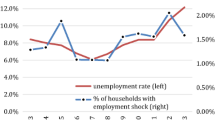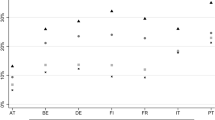Abstract
In this paper, we use a unique data set for Guatemala to estimate the effect of idiosyncratic shocks and credit constrains on children’s labor supply and schooling decisions. We extend Rosenbaum and Rubin (J R Stat Soc B 45:212–218, 1983b) analysis to the case of a multinomial outcome by proposing an innovative sensitivity analysis to assess the robustness of the estimates with respect to the presence of unobservables. The results show that credit rationing is an important determinant of school enrollment and children’s work. Exposure to negative shocks also strongly influences household decisions and pushes children to work, while access to coping mechanisms, like insurance, tends to increase education and to reduce child labor.
Similar content being viewed by others
Notes
Research has shown that income has a relatively small effect on the supply of child work (Cigno et al. 2002; Deb and Rosati 2003). Sustained income growth or large transfer programs would be necessary to substantially reduce child work. Moreover, it has been shown (Deb and Rosati 2003) that different groups of households have very different propensities to invest in children’s education, even if they have very similar sets of observable characteristics. Both findings are coherent with a potential role of credit rationing and the lack of “insurance” mechanisms, but they do not offer direct support to these hypotheses.
Several variations are possible within this class of models. For example, future consumption of parent’s could be included, as well as fixed costs in participating to work or school, etc. Nothing of substance would change in the results relevant to the present paper. For a detailed analysis see Cigno and Rosati (2005).
There were, on the other hand, serious problems with the response rate of the “community” questionnaire. We do not make use, however, of the information contained in this questionnaire in our analysis.
The extreme poverty line is defined as yearly cost of a “food of basket” that provides the minimum daily caloric requirement, estimated in Q. 1,912. The “non-extreme” poverty line (poor) is defined as the extreme poverty line plus an allowance for non-food items, estimated in Q. 4,319.
For a detailed description and analysis see Tesliue and Lindert (2002).
The rationale for the use of these variables is well known in the literature on child work, see Cigno and Rosati (2005) and the literature cited therein.
The multinomial logit model is even more flexible than the usual bivariate probit model, which takes account of the simultaneity of the decisions only through the correlation of the error terms. In fact, the covariates in the multinomial logit model may explicitly have a different effect on the probability of taking one of the four decisions. Also note that usual weakness of the conditional logit model, namely, the Independence of Irrelevant Alternatives (IIA) property, does not apply when, as in our case, most or all the covariates are individual characteristics (as opposed to choice specific characteristics), and each of them has coefficients that are choice specific (i.e., each of them enter the underlying stochastic utilities with a different coefficient): in this case, cross-elasticities are not constant, and including another alternative to the choice set does not leave the odds of the other alternatives unchanged.
Note however that a Bernoulli distribution can be thought of as a discrete approximation to any distribution, and thus, we believe that our distributional assumption will not severely restrict the generality of the results.
To do this, we used the procedure implemented in Stata by Becker and Ichino (2002).
Computed at the mean.
Estimates with the extended definition of work are not shown in the text, but are available from the authors.
See, for example, Cigno and Rosati (2005).
This seems to be confirmed by data on health status (see Cigno and Rosati 2005, and tabulation available for many countries at www.ucw-project.org.
Due to the nonlinearity of the model, marginal effects of the treatment variables can differ slightly from their ATT estimates because marginal effects vary with the value of the covariates.
References
Angrist J, Imbens GW (1995) Two-stage least squares estimation of average causal effects in models with variable treatment intensity. J Am Stat Assoc 90(430):431–442
Angrist JD, Krueger AB (1999) Empirical strategies in labor economics. In: Ashenfelter O, Card D (eds) Handbook of labor economics, vol 3. Elsevier Science B.V.
Angrist J, Imbens GW, Rubin DB (1996) Identification of causal effects using instrumental variables. J Am Stat Assoc 91:444–472
Baland JM, Robinson A (2000) Is child labor inefficient? J Polit Econ 108(4):663–679
Becker G, Tomes N (1976) Child endowment and the quantity and quality of children. J Polit Econ 87:1153–1189
Becker SO, Ichino A (2002) Estimation of average treatment effects based on propensity score. The Stata J 2(4):358–377
Beegle K, Dehejia R, Gatti R (2003) Child labor, income shokcs and access to credit, mimeo, World Bank
Beegle K, Dehejia R, Gatti R (2006) Child labor and agricultura shocks. J Dev Econ 81:80–96
Bjorklund A, Moffit R (1987) Estimation of wage gains and welfare gains in self-selection models. Rev Econ Stat 69:42–49
Cigno A, Rosati FC (2005) The economics of child labour. Oxford University Press, New York and Oxford
Cigno A, Rosati FC, Tzannatos Z (2002) Child labor handbook. World Bank Social Protection Discussion Paper N. 0206
Copas JB, Li HG (1997) Inference for non-random samples (with discussion). J R Stat Soc B 59:55–96
Deb P, Rosati FC (2003) Determinant of child labor and school attendance: the role of household unobservables. UCW working paper at www.ucw-project.org
Dehejia RH, Gatti R (2002) Child labor: the role of income variability and access to credit across countries, NBER WP 9018
Dehejia RH, Wahba S (1999) Causal effects in non experimental studies: reevaluation of the evaluation of training programs. J Am Stat Assoc 94:1053–1062
Edmonds E (2002) Is child labor inefficient? Evidence from large cash transfers. Dartmouth, Manuscript
ENCOVI (2000) Encuesta de condiciones de Vida 2000. Istituto Nacional de Estadisicas (INE) Guatemala
Heckman JJ (1989) Causal inference and nonrandom samples. J Educ Stat 14:159–168
Heckman JJ, Hotz VJ (1989) Choosing among alternative nonexperimental methods for estimating the impact of social programs: the case of manpower training. J Am Stat Assoc 84:862–880
Heckman JJ, Lalonde R, Smith J (1999) The economics and econometrics of active labor market programs. In: Ashenfelter O, Card D (eds) Handbook of labor economics, vol 3a. Elsevier Science B.V.
Holland PW (1986) Statistics and causal inference. J Am Stat Assoc 81:945–960
Holzmann R, Jorgensen S (2001) Social risk management: a new conceptual framework for social protection and beyond. Int Tax Public Financ 8(4):529–556
Ichino A, Mealli F, Nannicini T (2005) Temporary work agencies in Italy: a springboard toward permanent employment? Giornale degli Economisti e Annali di Economia 64(1):1–27
Ichino A, Mealli F, Nannicini T (2008) From temporary help jobs to permanent employment: what can we learn from matching estimators and their sensitivity? J Appl Econ 23(3):305–327
Imbens GW (2003) Sensitivity to exogeneity assumptions in program evaluation. AEA Pap Proc 93(2):126–132
Imbens GW (2004) Nonparametric estimation of average treatment effects under exogeneity: a review. Rev Econ Stat 86(1):4–29
Jacoby HG, Skoufias E (1997) Risk, financial markets, and human capital in a developing country. Rev Econ Stud 64(3):311–335
Jalan J, Ravallion M (2003) Estimating the benefit incidence of an antipoverty program by propensity score matching. J Bus Econ Stat 21(1):19–30
Lalonde RJ (1986) Evaluating the econometric evaluations of training programs, using experimental data. Econ Rev 76(4):602–620
Manski CF (1990) Nonparametric bounds on treatment effects. Am Econ Rev Pap Proc 80:319–323
Manski CF, Sandefur GD, McLanahan S et al (1992) Alternative estimates of the effects of family structure during adolescence on high school graduation. J Am Stat Assoc 87(417):25–37
Pratt JW, Schlaifer R (1988) On the interpretation and observation of laws. J Econom 39(1/2):23–52
Rosenbaum P, Rubin DB (1983a) The central role of the propensity score in observational studies for causal effects. Biometrika 70:41–55
Rosenbaum P, Rubin DB (1983b) Assessing sensitivity to an unobserved binary covariate in an observational study with binary outcome. J R Stat Soc B 45:212–218
Rubin DB (2002) Using propensity scores to help design observational studies: application to the tobacco litigation. Health Services Outcome Research Methodology
Tesliue ED, Lindert K (2002) Vulnerability: a qualitative and quantitative assessment, WB mimeo
World Bank (2001) Social protection sector strategy—from safety nets to springboard. The World Bank, Washington D.C.
Acknowledgements
We thank the participants to seminars at the World Bank, IZA, and the University of Rome “Tor Vergata”, and the two anonymous referees for their useful comments. We also thank Diane Steele for the fruitful discussion and Scott Lyon and Marco Manacorda for the careful reading of the manuscript and the valuable suggestions. The usual disclaimer applies.
This paper is part of the research carried out within UCW (Understanding Children’sWork), a joint ILO, World Bank and UNICEF project. The views expressed here are those of the authors’ and should not be attributed to the ILO, the World Bank, UNICEF or any of these agencies’ member countries.
Author information
Authors and Affiliations
Corresponding author
Additional information
Responsible editor: Alessandro Cigno
Appendices
Appendix 1
Questions used to define the some of the variables used in the estimation.
Appendix 2
Detailed descriptive statistics on shocks.
Appendix 3
Comparison of the distributions of propensity scores for treated and control groups.
Appendix 4
Rights and permissions
About this article
Cite this article
Guarcello, L., Mealli, F. & Rosati, F.C. Household vulnerability and child labor: the effect of shocks, credit rationing, and insurance. J Popul Econ 23, 169–198 (2010). https://doi.org/10.1007/s00148-008-0233-4
Received:
Accepted:
Published:
Issue Date:
DOI: https://doi.org/10.1007/s00148-008-0233-4








